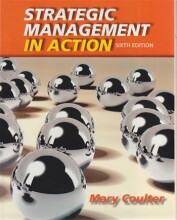Doing External analysis
12 important questions on Doing External analysis
Organisations are Open Systems: describe the Framework and draw the Table
Describe the external analysis process
- Systematically scanning the environment: a study of all segments General environment to detect changes that may occur now or in future. Critical in volatile environment; ambiguous, unconnected data
- Monitoring environment: observe environmental changes and try to spot trends emerging - take advantage of trends (middle-level manager)
- Forecasting environment: make feasible projections of what might happen, this brings Uncertainty
- Assessing: is the process of determining the significance of trends and changes in the environment on strategic management with the competitive relevance of the data.
Environment as source information for decision making, describe it
Stable environment: changes occur slowly, few environmental components (oil industry). External analysis provides the information about environment and reduces Uncertainty.
- Higher grades + faster learning
- Never study anything twice
- 100% sure, 100% understanding
Environment as source of resources, describe it?
Describe the organisation environment, draw it
Analyzing Specific environment includes industry and competitive environment; what is an industry?
What is Strategic group?
Threat of possible new entrants depends on Barriers of entry describe framework
Porter describe the 7 major Entry Barriers, describe them:
- Economies of scale: cost saving realised from volume (output) increase, fixed cost spread over large volume, driving cost per unit down
- Cost advantages from other than scale: existing competitors have cost advantages that possible competitors cannot duplicate: exclusive technology, government subsidy
- Product differentiation: existing Unique product differentiation or brand hard to overcome
- Capital requirements: possible competitors need ample financial resources to make high investment to compete (Compete with Boeing)
- Switching cost: cost to switch to another supplier (Psychological cost)
- Access Distribution channels: need to have set-up logical distribution source
- Government Policy: law or regulations: environmental, licensing, product standards
Responsibilities of doing external analysis
- Front-line employees hear comments or statements from outsiders important for strategic decision making
- Middle-level managers are information gatherer disseminator (announcer) of external information, about emerging trends to change strategies
- Top-level managers see whole picture and formulate Corporate strategies
Name challenges of doing external analysis
- Rapid changes in technology, new customers, new competitors or new regulations
- Amount of time it takes to do an External Analysis
- Forecast isn't facts just predictions of what might happen
Benefits of doing external analysis
- Identify possible Opportunities or threats, Manager can be pro-active, anticipate changes and plan for changes (in stead of reacting to them) Pro-active lobby and manage the environment (with EU commisssion)
- Provides information for strategic decision making, planning, strategy formulation. Can take possible action to change organisations and allign organisation with environment
- Environment source of resources: acquire and control resources (organisation open system; environment source of inputs (resources) to proces and produce outputs(products)
- Dynamic and rapid changing environment - need to examine environment
The question on the page originate from the summary of the following study material:
- A unique study and practice tool
- Never study anything twice again
- Get the grades you hope for
- 100% sure, 100% understanding































